Budgies are small and colorful birds that make great pets for many people. They are active and playful and can even learn to talk. However, like any other animal, they can also suffer from various health problems affecting their quality of life. One of these problems is when their foot needs to grip correctly.
A budgie’s foot comprises four toes: two pointing forward and two pointing backward. These toes have claws that help them grasp perches, toys, food, and other objects.
When a budgie’s foot does not grip properly, one or more of its toes or claws are not functioning normally. This can cause them difficulty balancing, perching, climbing, or playing. It can also cause them pain or discomfort when they try to use their foot.
In this article, we’ll discuss budgie foot not gripping – symptoms, causes, diagnosis, and treatment. So sit tight and read the whole article.
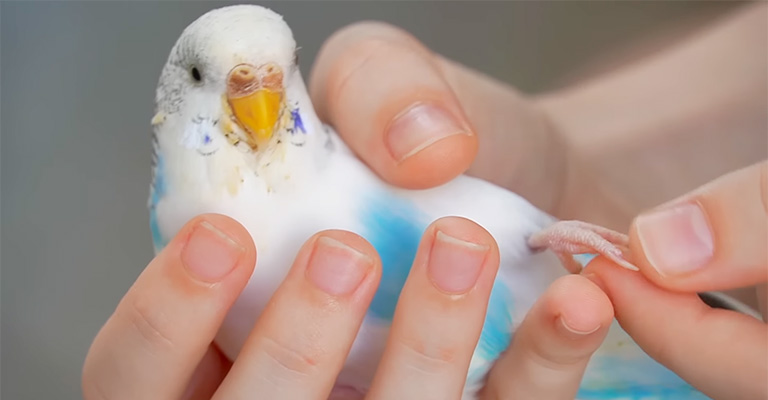
Budgie Foot Not Gripping -Symptoms
The symptoms of a budgie’s foot not gripping correctly depend on the cause and severity of the problem. Some of the common symptoms are:
Difficulty Perching Or Maintaining A Grip On Surfaces:
The budgie may struggle to hold onto perches or surfaces, frequently slipping or falling off. This indicates a problem with its foot’s ability to grip and maintain a secure hold.
Abnormal Foot Posture Or Position:
The affected foot may appear clenched, curled up, or have toes splayed out unnaturally. This abnormal posture suggests an issue with the budgie’s foot muscles or tendons, preventing it from gripping correctly.
Reluctance To Put Weight On The Affected Foot:
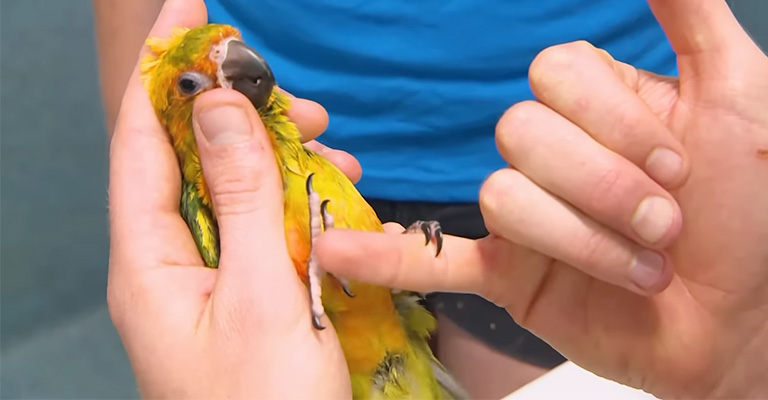
The budgie may avoid putting weight on foot altogether, favoring the healthy foot instead. This indicates discomfort or pain in the affected foot, making it challenging for the budgie to bear weight.
Loss Of Balance Or Frequent Falls:
The budgie may have difficulty maintaining balance due to the compromised grip. It may struggle to stay upright and experience frequent falls or stumbling when moving around or attempting to perch.
Reduced Ability To Move Around The Cage Or Hop:
The budgie’s impaired foot grip can limit mobility. It may have difficulty moving around the cage, hopping from one perch to another, or climbing toys or branches.
Signs Of Discomfort Or Pain When Attempting To Grip:
The budgie may exhibit signs of distress, such as flinching, vocalizing, or biting when trying to grip the affected foot. These behaviors indicate that the bird experiences pain or discomfort when attempting to use the foot.
Swelling Or Inflammation In The Foot Area:
If the budgie’s foot is not gripping correctly, it may exhibit visible signs of swelling, redness, or inflammation in the affected area. These symptoms could suggest an injury, infection, or underlying health condition affecting the foot.
Behavior Or Activity Level Change:
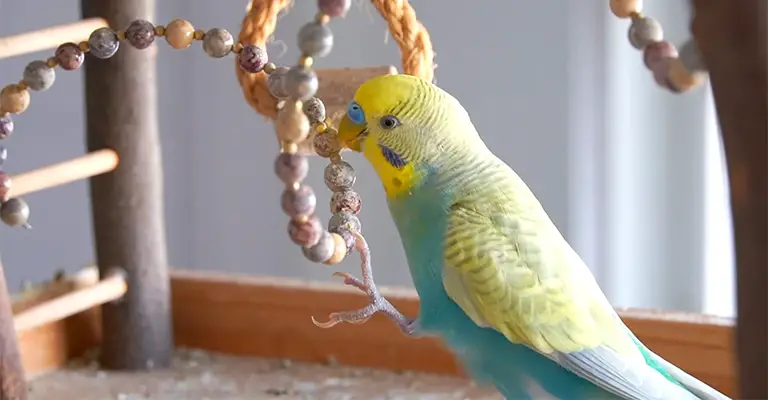
Budgies with foot grip issues may alter their behavior. They may become less active, reluctant to engage in everyday activities or rest more. These changes occur due to the discomfort and limited mobility caused by the foot problem.
Possible Signs Of Injury, Such As Bleeding Or Visible Wounds:
In some cases, budgies may have visible signs of injury on their feet, such as bleeding, cuts, or open wounds. These injuries could result from accidents, trauma, or self-inflicted harm due to the bird’s attempts to alleviate foot discomfort.
Generalized Weakness Or Lethargy:
If the budgie cannot grip with its foot, it may experience overall weakness or lethargy. The bird may seem less energetic, have a reduced appetite, or lack interest in its surroundings. These symptoms can occur due to pain, discomfort, or the strain of compensating for the affected foot.
Budgie Foot Not Gripping- Causes
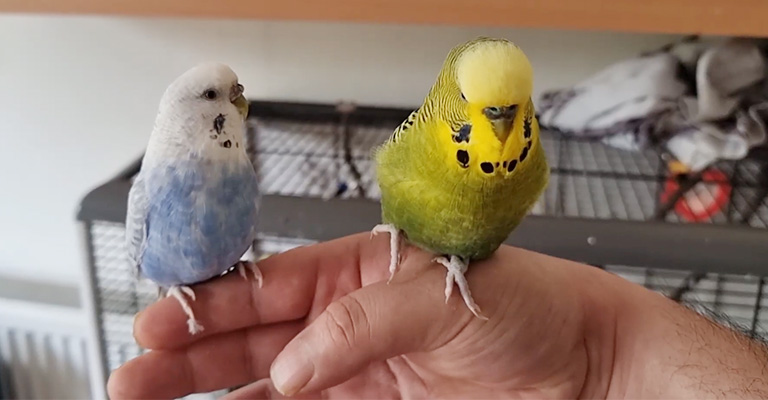
There are many possible causes for a budgie’s foot not gripping correctly. Some of them are:
Injuries:
A budgie can injure its foot by catching it on something, falling from a height, or being bitten by another bird or animal. This can result in twisted or broken toes, sprained or dislocated joints, fractures, wounds, or infections.
Infections:
A budgie can develop infections in its foot due to bacteria, fungi, parasites, or viruses. Some common diseases are bumblefoot (a form of pododermatitis that causes swollen and painful feet), scaly leg (a condition caused by mites that makes the skin dry and flaky), and avian pox (a viral disease that causes warts or lesions on the skin).
Nutritional deficiencies:
A budgie can suffer from nutritional deficiencies if it needs more vitamins, minerals, or other nutrients. This can affect its immune system, making it more prone to infections and diseases.
Some common deficiencies are vitamin A (which affects the skin and mucous membranes), calcium (which affects the bones and muscles), and iodine (which affects the thyroid gland).
Diseases:
A budgie can have conditions that affect its nervous system or metabolism. This can impair its ability to control its muscles or regulate its body functions.
Some common diseases are gout (a disorder that causes uric acid crystals to accumulate in the joints), diabetes (a disorder that affects blood sugar levels), and stroke (a condition that occurs when the blood supply to the brain is interrupted).
Budgie Foot Not Gripping- Diagnosis & Treatment
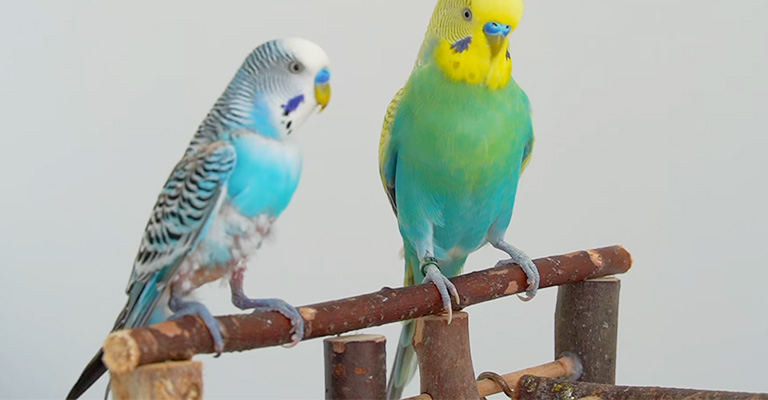
Suppose you notice any of these symptoms in your budgie. In that case, you should take it to a veterinarian experienced with birds as soon as possible.
The veterinarian will examine your budgie’s foot and ask you some questions about its history and environment. They may also perform some tests such as x-rays, blood tests, or cultures to determine the cause and extent of the problem.
The treatment for a budgie’s foot not gripping correctly will depend on the diagnosis and prognosis of the problem. Some of the possible treatments are:
Medication:
The veterinarian may prescribe antibiotics, anti-inflammatories, painkillers, or supplements to treat infections, inflammation, pain, or deficiencies.
Surgery:
The veterinarian may perform surgery to repair fractures, dislocations, wounds, or abscesses in the foot.
Splinting:
The veterinarian may apply a splint or a bandage to immobilize the foot and allow it to heal.
Amputation:
The veterinarian may amputate the affected toe or foot if it is severely damaged or infected and cannot be saved.
Euthanasia:
The veterinarian may euthanize the budgie if it suffers from a terminal or incurable disease and cannot recover.
Budgie Foot Not Gripping- Recovery:

The recovery time for a budgie’s foot not gripping properly will vary depending on the cause and treatment of the problem. Some budgies may recover quickly and resume normal activities, while others may need more time and care to heal. Some budgies may also have permanent disabilities or complications that affect their quality of life.
To prevent or manage a budgie’s foot from not gripping correctly, you should follow these tips:
- Provide a balanced and varied diet that meets your budgie’s nutritional needs. As your veterinarian recommends, include fresh fruits, vegetables, seeds, pellets, and supplements.
- Provide clean and fresh water at all times and change it daily.
- Provide a clean and spacious cage with appropriate perches, toys, and accessories for your budgie. Avoid nests that are too rough, smooth, hard, or soft. Choose nests made of natural materials such as wood or rope with different diameters and textures.
- Avoid perches that are made of plastic, metal, or sandpaper. Also, avoid toys that have sharp edges, loose parts, or toxic materials.
- Clean the cage regularly and remove droppings, food debris, or other waste. Disinfect the cell and its contents periodically with a bird-safe cleaner.
- Check your budgie’s feet daily for any signs of injury or infection. Trim your budgie’s nails regularly to prevent them from becoming too long or sharp. If you are not confident in doing this, ask your veterinarian or a professional groomer.
- Keep your budgie away from other birds or animals that may harm it. Also, please keep it away from sources of heat, cold, drafts, or chemicals that may irritate its skin.
- Monitor your budgie’s behavior and activity levels and look for any changes that may indicate a problem. If you notice anything unusual or concerning, consult your veterinarian immediately.
FAQs
A budgie can live with one foot if it is healthy and well-cared for. However, it may face some challenges, such as balancing, perching, climbing, or playing. It may also need special accommodations, such as lower perches, softer bedding, or ramps to help it move around.
Budgies are very good at hiding their pain, so it may not be easy to tell if they are in pain. However, some signs that may indicate pain are squawking loudly when touched, avoiding contact with the affected area, limping or favouring one foot, holding one leg up, trembling or shaking, becoming less active or playful, losing appetite or weight, or showing aggression or fear.
You can make your budgie more comfortable by providing a warm and cosy environment. You can use a heating pad, a heat lamp, or a warm water bottle to give some extra warmth. Cover the cage with a blanket or towel to create darkness and privacy. You can also offer treats or toys to distract your budgie from pain.
You can prevent your budgie from injuring its foot by providing a safe cage with appropriate perches, toys, and accessories. You should also avoid exposing your budgie to potential hazards such as other birds or animals that may harm it, sources of heat or cold that may burn or freeze its skin, drafts or chemicals that may irritate its skin, or objects that may catch or cut its foot.
You should not attempt to treat your budgie’s foot at home without consulting your veterinarian first. Some home remedies may be harmful or ineffective for your budgie. The best thing you can do is to keep your budgie comfortable and calm until you can take it to the veterinarian.
Conclusion
Now you know about budgie foot not gripping – symptoms, causes, diagnosis, and treatment. Actually, a budgie’s foot not gripping correctly is a common problem with various causes and symptoms.
It can affect your budgie’s ability to balance, perch, climb, or play. It can also cause your budgie pain or discomfort. Suppose you notice any signs of a problem with your budgie’s foot. In that case, you should take it to a veterinarian experienced with birds as soon as possible.
The veterinarian will diagnose the problem and prescribe the best treatment for your budgie’s condition. By following the veterinarian’s advice and taking good care of your budgie, you can help your budgie recover and prevent further complications.